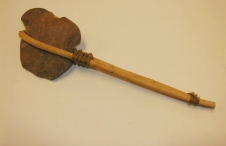Abandonment of Lost City
The end of the Anasazi occupation of Nevada's Lost City is an ongoing research question for archaeologists. Some of the reasons considered are long-term drought, overpopulation, disease, or competition for resources. Social issues and religion may have also contributed. A combination of all of these was probably responsible for the end of Anasazi culture in this area.
Studies of tree ring and climate data show there were extended prehistoric periods of drought throughout the Southwest. Populations grew through the Pueblo II period and may have reached a point where they could survive in good times but could not support larger communities when crops failed. As people moved away, the social communities would have been disrupted and other more nomadic groups may have been competing for the surrounding resources that had always been a backup to agricultural crops.
Failed crops and malnutrition make populations more vulnerable to disease. Rapidly spreading disease does not always leave marks on the bones. Native American groups are reluctant to have invasive tests run on their ancestors' remains. We do not have direct evidence, but disease among the Anasazi could have been a contributing factor to cultural collapse and abandonment.
Some late Pueblo II sites appear to be in "defensive" positions but there is no direct evidence of violent death that would hint at warfare. There may have been pressure and competition for resources but that is not proven.
Social changes began to develop in the Southwest near the time of the abandonment of the Lost City. The Katsina religion was becoming important and groups of people from throughout the region were relocating in central ceremonial sites to be near priests who practiced the new religion.
Some of the Anasazi may have moved east from the Lost City area to join other Anasazi groups but there is no evidence of mass migration. Mesa Verde and Chaco Canyon were abandoned about one hundred years after the Lost City. The Hopi in Arizona claim these people, Hisatsinom, as their ancestors. DNA testing could provide answers but would require destroying small pieces of the bones recovered from burials. To the Hopi and most other Native American groups that invasion is unthinkable. They are comfortable with traditional stories that tell them how their people came to be where they are.
Some Native American groups say their people have always been in this location, and there was no abandonment. Archaeologists are researching the possibility that the Anasazi remained but for some reason their technology and culture changed drastically. This "continuity" hypothesis is not conclusive.






